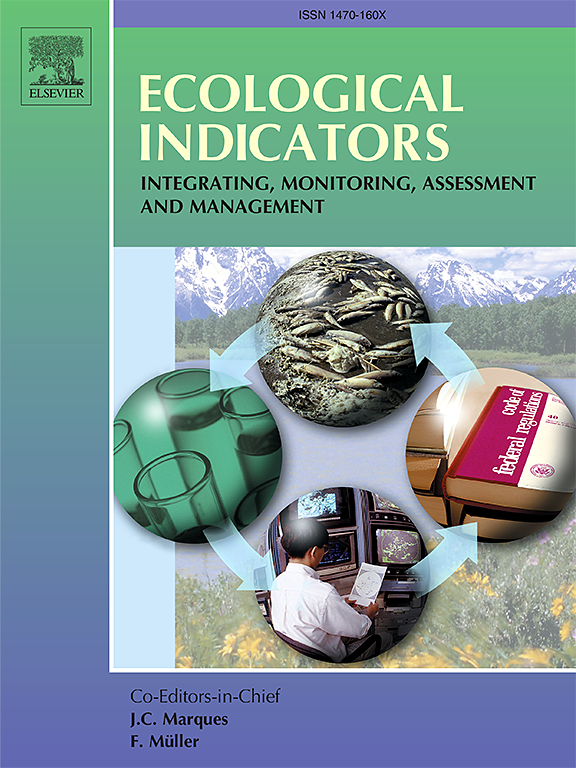Responses of soil carbon, nitrogen, and phosphorus stoichiometry to afforestation of severely desertified land in northern China
IF 7
2区 环境科学与生态学
Q1 ENVIRONMENTAL SCIENCES
引用次数: 0
Abstract
Large-scale afforestation is being implemented globally to promote carbon sequestration in ecosystems, address climate change, and restore degraded ecosystems. However, the impacts of trees and shrubs on soil stoichiometry in severely desertified land remain unclear. We investigated the topsoil (0 − 20 cm) carbon, nitrogen, and phosphorus (C:N:P) stoichiometry of Pinus sylvestris var. mongolica and Caragana microphylla plantations established on mobile sand dunes in northern China. Soil organic carbon (SOC, 2.6 to 11.3 g kg−1) and total nitrogen (TN, 0.3 to 1.2 g kg−1) concentrations increased by 3.2 to 6.5 times the values in mobile dunes, on average, after 40 years of afforestation. Total phosphorus (TP, 0.1 to 0.2 g kg−1) in the 40-year-old P. sylvestris and C. microphylla plantations increased by 15.1 and 24.3 %, respectively. Well-constrained C:N ratios (7.7 to 10.1 on average) indicated strong coupling relationship between SOC and TN. The average C:P (7.2 to 43.8) and average N:P (0.8 to 4.4) ratios increased with increasing afforestation age due to disproportionate changes in the three elements, but the rate of increase under C. microphylla decreased. N:P ratios under P. sylvestris increased with increasing afforestation age, indicating that long-term P. sylvestris afforestation may become P-limited. Environmental factors explained 75 % of the total variation of soil C:N:P stoichiometry. The improved plant diversity, productivity, and soil physical properties after afforestation improved the soil C:N:P stoichiometry. Climate and terrain had negative impacts on this stoichiometry. We suggest combining multiple species for afforestation to improve species diversity and providing supplemental P in later stages of afforestation to counteract the future P limitation. Our findings provide new knowledge on the relationships between afforestation and soil stoichiometry in severely desertified areas, and provide a reference for optimizing afforestation.
中国北方严重沙化土地土壤碳、氮、磷化学计量对造林的响应
全球正在实施大规模植树造林,以促进生态系统固碳、应对气候变化和恢复退化的生态系统。然而,乔木和灌木对严重荒漠化土地土壤化学计量的影响仍不清楚。我们研究了在中国北方流动沙丘上种植的蒙古松(Pinus sylvestris var.造林 40 年后,土壤有机碳(SOC,2.6-11.3 g kg-1)和总氮(TN,0.3-1.2 g kg-1)的浓度平均增加了 3.2-6.5 倍。40 年树龄的 P. sylvestris 和 C. microphylla 人工林中的总磷(TP,0.1-0.2 g kg-1)分别增加了 15.1% 和 24.3%。良好的 C:N 比值(平均为 7.7 至 10.1)表明 SOC 与 TN 之间有很强的耦合关系。随着造林年龄的增加,平均 C:P 比值(7.2-43.8)和平均 N:P 比值(0.8-4.4)也随之增加,这是由于三种元素的变化不成比例,但在 C. microphylla 下增加的速度有所下降。P.sylvestris下的N:P比率随着造林年龄的增加而增加,表明长期的P.sylvestris造林可能会导致P受限。环境因素解释了 75% 的土壤 C:N:P 化学计量学总变化。植树造林后,植物多样性、生产力和土壤物理特性的提高改善了土壤 C:N:P 的化学计量。气候和地形对这一化学计量产生了负面影响。我们建议结合多种物种进行造林,以提高物种多样性,并在造林后期补充 P,以应对未来的 P 限制。我们的研究结果为严重荒漠化地区植树造林与土壤化学计量之间的关系提供了新的知识,并为优化植树造林提供了参考。
本文章由计算机程序翻译,如有差异,请以英文原文为准。
求助全文
约1分钟内获得全文
求助全文
来源期刊

Ecological Indicators
环境科学-环境科学
CiteScore
11.80
自引率
8.70%
发文量
1163
审稿时长
78 days
期刊介绍:
The ultimate aim of Ecological Indicators is to integrate the monitoring and assessment of ecological and environmental indicators with management practices. The journal provides a forum for the discussion of the applied scientific development and review of traditional indicator approaches as well as for theoretical, modelling and quantitative applications such as index development. Research into the following areas will be published.
• All aspects of ecological and environmental indicators and indices.
• New indicators, and new approaches and methods for indicator development, testing and use.
• Development and modelling of indices, e.g. application of indicator suites across multiple scales and resources.
• Analysis and research of resource, system- and scale-specific indicators.
• Methods for integration of social and other valuation metrics for the production of scientifically rigorous and politically-relevant assessments using indicator-based monitoring and assessment programs.
• How research indicators can be transformed into direct application for management purposes.
• Broader assessment objectives and methods, e.g. biodiversity, biological integrity, and sustainability, through the use of indicators.
• Resource-specific indicators such as landscape, agroecosystems, forests, wetlands, etc.
 求助内容:
求助内容: 应助结果提醒方式:
应助结果提醒方式:


